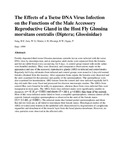The Effects of a Tsetse DNA Virus Infection on the Functions of the Male Accessory Reproductive Gland in the Host Fly Glossina morsitans centralis (Diptera; Glossinidae)

View/
Date
1999Author
Sang, R C
Jura, W G
Otieno, L H
Mwangi, R W
Ogaja, P
Type
ArticleLanguage
enMetadata
Show full item recordAbstract
Freshly deposited third instar Glossina morsitans centralis larvae were infected with the tsetse DNA virus by microinjection, and at emergence adult males were separated from the females and fed on rabbit blood every second day for 8 days. A control group treated with sterile saline were handled similarly. They were dissected, and comparative observations made on the appearance and size of the accessory reproductive glands (ARG) in infected and control males. Regularly fed 8-day-old males from infected and control groups were mated to 2-day-old normal females obtained from the insectay. After separation from copula, the females were dissected and the uteri examined for the presence and quality of the spermatophore. The spermathecae were also examined for insemination. ARG tissues from the control and virus infected regularly fed 8-day-old male flies were fixed and processed for electron microscopic studies.
The ARGs from control flies were found to be milky in appearance, whereas those from virus-infected flies were transparent in most parts. The ARGs from virus-infected males were significantly smaller in diameters (F = 42.26, p < 0.0001) and shorter (F = 200.4, p < 0.0001) than those of the controls.
Most of the virus-infected males failed to form a complete spermatophore, whereas almost all the controls formed complete spermatophore as observed in the uteri of the female mates (Χ2 = 111.661, p < 0.0001). The infected males that formed partial spermatophores and those that did not form any at all failed to inseminate their female mates.
Histological studies of the ARGs revealed some lesions in the epithelial cells characterized by degeneration of cytoplasmic organelles and detachment of the muscle layer from the basal plasma membrane. However, no virus particles were observed in the affected cells.
URI
http://link.springer.com/article/10.1007/PL00006815http://erepository.uonbi.ac.ke:8080/xmlui/handle/123456789/47974
Citation
Sang, R. C., Jura, W. G., Otieno, L. H., Mwangi, R. W., & Ogaja, P. (1999). The effects of a tsetse DNA virus infection on the functions of the male accessory reproductive gland in the host fly Glossina morsitans centralis (Diptera; Glossinidae). Current microbiology, 38(6), 349-354.Publisher
University of Nairobi, School of Biological and Physical Sciences
